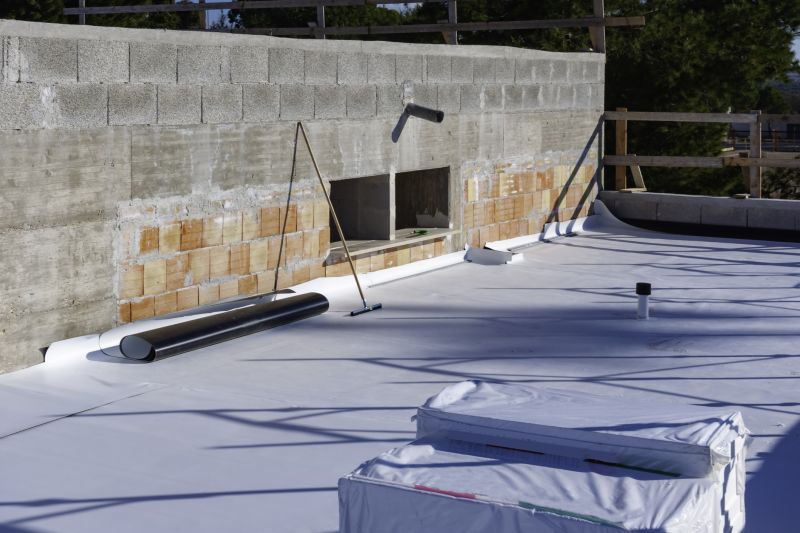Expert Picks for Tpo Roof Installation Supplies and Materials
Get insights into top-performing products favored by roofing experts for effective Tpo roof installation outcomes.
 Tpo roof installation projects require a range of specialized products designed to ensure durability, weather resistance, and proper sealing. Choosing the right materials can influence the longevity and performance of the roofing system. From membrane sheets to adhesives and sealants, a comprehensive selection of products is essential for a successful installation. These components must be compatible with Tpo membranes and suitable for various roofing conditions, including flat and low-slope roofs.
Tpo roof installation projects require a range of specialized products designed to ensure durability, weather resistance, and proper sealing. Choosing the right materials can influence the longevity and performance of the roofing system. From membrane sheets to adhesives and sealants, a comprehensive selection of products is essential for a successful installation. These components must be compatible with Tpo membranes and suitable for various roofing conditions, including flat and low-slope roofs.
Top Overall Option
Tpo Roofing Membrane Sheets
Tpo roofing membrane sheets serve as the foundational layer for Tpo roof installations. These sheets are made from flexible, durable thermoplastic polyolefin material designed to withstand environmental stresses. They are available in various thicknesses and sizes to accommodate different project requirements. Properly installed membrane sheets provide a seamless surface that resists UV radiation, chemical exposure, and temperature fluctuations, contributing to the overall longevity of the roof.
Types of Products For Tpo Roof Installations
Tpo Roofing Membrane Sheets
Flexible sheets that form the main waterproof surface of Tpo roofing systems, available in different thicknesses and widths.
Adhesives and Seam Tapes
Specialized adhesives and tapes used to bond membrane sheets and seal seams, ensuring watertight joints.
Roof Sealants
Sealants designed to fill gaps and seal around penetrations, vents, and flashing components for added protection.
Flashing Materials
Metal or membrane flashing options used to protect roof edges, penetrations, and joints from water intrusion.
Fasteners and Plates
Mechanical fasteners and plates that secure membrane sheets to the substrate, especially in mechanically attached systems.
Primers
Surface primers that improve adhesion of membranes and sealants to various substrates before installation.
Insulation Boards
Insulation panels that enhance energy efficiency and provide a stable surface for membrane installation.
Edge Termination Devices
Components used to neatly finish roof edges and prevent water infiltration at perimeter areas.
Lap Sealants
Sealants used to secure overlaps and seams between membrane sheets for added waterproofing.
Roof Drainage Components
Drainage products such as scuppers and gutters designed to facilitate water removal from the roof surface.
Vapor Barriers
Materials used to prevent moisture migration and protect the roof structure from condensation issues.
Roof Coatings
Protective coatings applied over membranes to enhance UV resistance and surface durability.
Edge and Corner Pavers
Pavers used at roof edges and corners to provide additional protection and aesthetic finish.
Fastening Tools
Tools such as pneumatic guns and drills used to install fasteners and other mechanical components efficiently.
Leak Detection Kits
Tools and materials used to identify potential leaks and ensure proper sealing during installation.
Popular Choices
Widely used as the primary waterproofing layer, available in various sizes and thicknesses.
Commonly used for sealing seams and joints to ensure a continuous waterproof surface.
Popular for sealing around penetrations and edges to prevent water ingress.
Frequently selected for mechanically attached Tpo systems to secure membranes in place.
Essential for preparing surfaces to maximize adhesion of membranes and sealants.
Commonly used to protect roof perimeters and penetrations from water intrusion.
Popular for improving energy efficiency and providing a stable base for membrane installation.
Frequently used to secure overlaps and seams for enhanced waterproofing.
Often applied to extend membrane life and improve surface resilience.
Commonly chosen to neatly finish roof edges and prevent water infiltration.
Popular for effective water removal and preventing ponding on the roof surface.
Selected to control moisture migration within roofing assemblies.
Used for identifying potential leak points during and after installation.
The installation process involves precise application of each product type to create a seamless, watertight surface. Proper preparation, such as cleaning and surface priming, is critical to ensure adhesion and performance. Quality accessories like seam tapes, flashing materials, and fasteners contribute to the overall integrity of the roof. It is also important to consider weather conditions during installation, as some products may require specific temperatures or humidity levels for optimal application.
Investing in high-quality products can help prevent issues like leaks, membrane punctures, or seam failures over time. Regular inspection and maintenance are recommended to preserve the roof’s condition. When selecting products, it is vital to verify compatibility with Tpo membranes and to follow manufacturer guidelines for installation procedures. This comprehensive approach can support the creation of a resilient roofing system that performs well across various conditions.
Key Buying Considerations
- Compatibility with Tpo membranes and other roofing components.
- Product thickness and durability suited to your project’s environmental conditions.
- Adhesion properties and ease of application for sealing seams and penetrations.
- Weather resistance, including UV stability and chemical resistance.
- Compatibility with existing roofing materials if retrofitting.
- Ease of handling and installation, especially for large membrane sheets.
- Availability of accessories like seam tapes, flashings, and sealants.
- Manufacturer specifications and adherence to industry standards.
- Cost-effectiveness relative to project scope and longevity expectations.
- Availability of technical support and detailed installation instructions.
- Compatibility with insulation and other underlying materials.
- Environmental conditions during installation, such as temperature and humidity.
- Potential need for specialized tools or equipment for installation.
- Warranty options and manufacturer reputation for quality.
- Ease of future maintenance and repair access.
